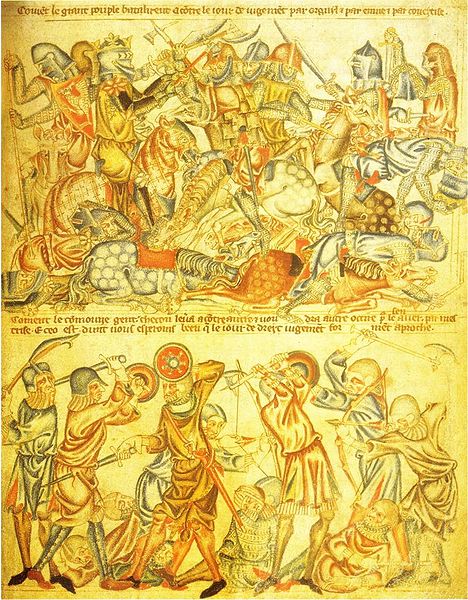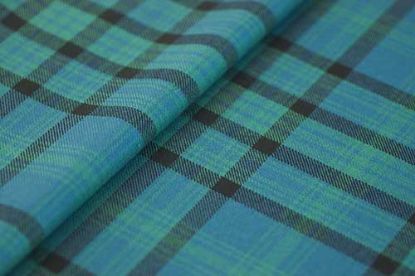10th May 1307 Battle of Loudon Hill
Having rallied his supporters, King Robert was back in business again and came up against his old adversary Aymer de Valence, now Earl of Pembroke, ten miles north of Kilmarnock in Ayrshire. This time the English soldiers were obliged to approach their enemy over bogland, and rapidly fell victim to the spears of Bruce's men. Over one hundred were killed before the remainder rapidly dispersed.
22nd May 1308 Battle of Inverurie (sometimes known as the Battle of Barra)
King Robert was taken ill on his march north towards Aberdeenshire after his victory at Loudon Hill, but the spring of 1308 nevertheless found him and his army camped at Meldrum, close to Inverurie. John Comyn, 3rd Earl of Buchan, was a cousin of the murdered John Comyn, Lord of Buchan, and determined to bring the King to justice. However, he proved indecisive. Many of his followers had been assured that the King was too ill to fight and when King Robert appeared before them, Buchan's men turned and fled. Buchan himself escaped to England where he died the same year.
Circa 1308/1309 Battle of the Pass of Brander
This was a conflict between King Robert I and the Macdougalls of Argyll, kinsmen of the murdered John Comyn. There is variance as to exactly where (Brander or Ben Cruachan) and when the incident took place, but it is generally understood that the Macdougalls were caught in a vice between King Robert and Sir James Douglas and put to flight.
 |
Depiction of the Battle of Bannockburn, Holkham Bible c.1330 |
23/24th June 1314 Battle of Bannockburn
This was the decisive victory of the Scots against the English in the First War of Scottish Independence. Although King Robert had largely succeeded in re-establishing the Kingdom of Scots, Stirling Castle still remained under English command and it was here that Edward II determined that he would confront the Scots once and for all. With an army numbering 4,000 men he marched north, mustering his forces at Berwick and crossing the River Tweed at Coldstream.
The English army arrived at the Bannock Burn, just out of range of the canon shot of Stirling Castle, on midsummer's eve. Priot to the battle, a young English knight, Henry de Bohun, a nephew of the Earl of Hertford, challenged King Robert to a dual and was struck to the ground by the King's axe.
Following the example set by Sir William Wallace, the King's army, which had been rallied from every corner of Scotland, was largely composed of spear men. The very size of the English army worked to its detriment, with its large numbers dispersing in confusion as the Scots emerged from the cover of the woods. As the English formation broke, a great shout rang out from the Scots and victory was assured.
25th August 1330 Battle of Teba (in Andalusia, Spain)
It had always been King Robert's desire to take part in a Crusade as a form of penance for the murder of his cousin John Comyn in 1306. It was therefore his dying wish that his embalmed heart be taken on such a mission by his good friends Sir James “The Good” Douglas; Sir William St Clair and his brother, John St Clair; Sir William Borthwick; Sir Simon Lockhard of the Lee; Sir William Keith; Sir Robert Logan of Restalrig, and Sir Walter Logan.
In the spring of 1330, therefore, a party of Scottish knights and esquires set off to mainland Europe with the heart and a letter of recommendation from the King of England to King Alfonso XI of Castile who was at the time embroiled in a war against Muhammed XI, Sultan of Granada.
Arriving in Seville at the end of July, the group were welcomed and at once seconded to the Castello de la Estrella, which was being occupied by the Sultan's forces. It was perhaps a headstrong but excusable misunderstanding. The Moors were assembled beneath the castle walls and, assuming that King Alphonso's army was behind him, Sir James led a charge into the midst of enemy. He was immediately surrounded and killed, calling out as he threw the silver casket containing King Robert's heart ahead of him: "Now pass thou onward before us, as thou wast wont, and I will follow thee or die."
Ironically, the Castilians won the day, but only two of the Scottish knights, Keith and Lockhart, survived. The bodies of Sir James and the other fallen knights were returned to Scotland along with the heart of King Robert in its silver casket. It was soon afterwards interred at Melrose Abbey.
14th October 1322 Battle of Old Byland
After their great victory at Bannockburn, the Scots regularly raided into England without resistance. Taking advantage of the prospect of a civil war in England, King Robert encouraged his commanders Sir James Douglas, Thomas Randolph, 1st Earl of Moray and Walter Stewart to mount a foray into the North East while King Edward II was preoccupied with bringing his rebel barons to heel. At first, the Scots incursion was largely ignored but when Edward had finally suppressed his close-at-hand opponents at the Battle of Boroughbridge, he determined to retaliate on Scotland and invaded.
King Robert immediately adopted a scorched earth policy, retreating north across the Firth of Forth. Edward, his troops ravished by hunger, succeeded in reaching Edinburgh and destroyed Holyrood Abbey. Meanwhile, the Scots army had moved in a circular movement to the south west, crossing the Solway Firth into England and, turning east, intercepted the homecoming English army in North Yorkshire. The subsequent confrontation turned into a rout with Edward's commander, John de Bretagne, 1st Duke of Richmond, taken prisoner. Edward himself was forced to make a rapid escape from Rievaulx Abbey.
























